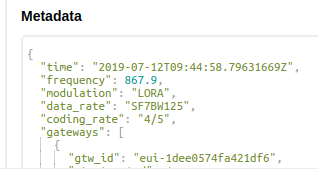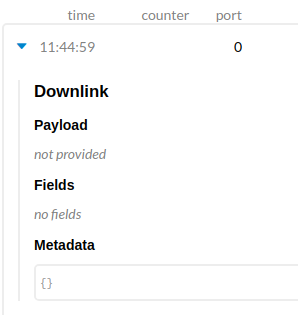I’m not exactly sure how to interpret the mac command messages yet, but I managed to get them printed out. After a join I force LMIC to SF12BW125 and let ADR push it back down to SF7BW125, which happends almost immediately (SF12->SF8->SF7 in 3 uplinks). But after we get to SF7 I don’t see any downlink MAC commands anymore, so I assume TTN’s ADR doesn’t push the device down to the FSK channel.
14:36:41.190 -> Starting
14:36:41.224 -> Packet queued
14:36:41.257 -> 312848: EV_JOINING
14:36:52.613 -> 563562: EV_TXSTART: ch 0 rps=0x1 (SF7 BW125 CR 4/5 Crc IH=0), datarate 5, opmode 88C
14:36:52.679 -> 871932: EV_RXSTART: freq=868.1 rps=0x81 (SF7 BW125 CR 4/5 NoCrc IH=0), datarate 5, opmode 88C, txend 567452, delta ms 4871
14:36:52.679 -> 885512: EV_JOINED: ch 0
14:36:52.679 -> netid: 19
14:36:52.679 -> devaddr: <redacted>
14:36:52.679 -> artKey: <readacted>
14:36:52.679 -> nwkKey: <redacted>
14:36:52.679 -> 886298: EV_TXSTART: ch 3 rps=0x1 (SF7 BW125 CR 4/5 Crc IH=0), datarate 5, opmode 888
14:36:52.679 -> 949691: EV_RXSTART: freq=867.1 rps=0x81 (SF7 BW125 CR 4/5 NoCrc IH=0), datarate 5, opmode 888, txend 890318, delta ms 949
14:36:52.746 -> 1009441: EV_RXSTART: freq=869.5 rps=0x83 (SF9 BW125 CR 4/5 NoCrc IH=0), datarate 5, opmode 888, txend 890318, delta ms 1905
14:36:52.746 -> 1023215: EV_TXCOMPLETE: ch 3 rps=0x83 (SF9 BW125 CR 4/5 NoCrc IH=0) txrxflags 0x20
14:36:57.630 -> Packet queued
14:37:01.449 -> Received message on port 0: 0 bytes
14:37:01.449 -> MAC message: 60 1A 2F 1 26 85 0 0 3 41 FF 0 1
14:37:01.515 -> 1336500: EV_TXSTART: ch 0 rps=0x6 (SF12 BW125 CR 4/5 Crc IH=0), datarate 0, opmode 888
14:37:01.515 -> 1501956: EV_RXSTART: freq=868.1 rps=0x86 (SF12 BW125 CR 4/5 NoCrc IH=0), datarate 0, opmode 888, txend 1439571, delta ms 998
14:37:01.515 -> 1558693: EV_RXSTART: freq=869.5 rps=0x83 (SF9 BW125 CR 4/5 NoCrc IH=0), datarate 0, opmode 888, txend 1439571, delta ms 1905
14:37:01.515 -> 1575831: EV_TXCOMPLETE: ch 0 rps=0x83 (SF9 BW125 CR 4/5 NoCrc IH=0) txrxflags 0x22
14:37:06.461 -> Packet queued
14:37:53.421 -> Received message on port 0: 0 bytes
14:37:53.421 -> MAC message: 60 1A 2F 1 26 A5 1 0 3 51 FF 0 1
14:37:53.421 -> 4742157: EV_TXSTART: ch 4 rps=0x2 (SF8 BW125 CR 4/5 Crc IH=0), datarate 4, opmode 888
14:37:53.421 -> 4809533: EV_RXSTART: freq=867.3 rps=0x82 (SF8 BW125 CR 4/5 NoCrc IH=0), datarate 4, opmode 888, txend 4750032, delta ms 952
14:37:53.421 -> 4819185: EV_TXCOMPLETE: ch 4 rps=0x82 (SF8 BW125 CR 4/5 NoCrc IH=0) txrxflags 0x21
14:37:58.338 -> Packet queued
14:39:43.423 -> Received message on port 0: 0 bytes
14:39:43.489 -> MAC message: 60 1A 2F 1 26 A5 2 0 3 51 FF 0 1
14:39:43.489 -> 11628265: EV_TXSTART: ch 1 rps=0x1 (SF7 BW125 CR 4/5 Crc IH=0), datarate 5, opmode 888
14:39:43.489 -> 11691851: EV_RXSTART: freq=868.3 rps=0x81 (SF7 BW125 CR 4/5 NoCrc IH=0), datarate 5, opmode 888, txend 11632478, delta ms 949
14:39:43.489 -> 11698696: EV_TXCOMPLETE: ch 1 rps=0x81 (SF7 BW125 CR 4/5 NoCrc IH=0) txrxflags 0x21
14:39:48.404 -> Packet queued
14:39:51.163 -> 12045747: EV_TXSTART: ch 2 rps=0x1 (SF7 BW125 CR 4/5 Crc IH=0), datarate 5, opmode 888
14:39:51.263 -> 12109461: EV_RXSTART: freq=868.5 rps=0x81 (SF7 BW125 CR 4/5 NoCrc IH=0), datarate 5, opmode 888, txend 12050088, delta ms 949
14:39:51.263 -> 12169209: EV_RXSTART: freq=869.5 rps=0x83 (SF9 BW125 CR 4/5 NoCrc IH=0), datarate 5, opmode 888, txend 12050088, delta ms 1905
14:39:51.263 -> 12182855: EV_TXCOMPLETE: ch 2 rps=0x83 (SF9 BW125 CR 4/5 NoCrc IH=0) txrxflags 0x20
.
.
.
14:47:30.039 -> Packet queued
14:47:31.168 -> Received message on port 0: 0 bytes
14:47:31.168 -> MAC message: 60 1A 2F 1 26 A5 3 0 3 55 FF 0 1
14:47:31.234 -> 40857996: EV_TXSTART: ch 7 rps=0x1 (SF7 BW125 CR 4/5 Crc IH=0), datarate 5, opmode 888
14:47:31.234 -> 40921387: EV_RXSTART: freq=867.9 rps=0x81 (SF7 BW125 CR 4/5 NoCrc IH=0), datarate 5, opmode 888, txend 40862014, delta ms 949
14:47:31.234 -> 40928235: EV_TXCOMPLETE: ch 7 rps=0x81 (SF7 BW125 CR 4/5 NoCrc IH=0) txrxflags 0x21
14:47:36.177 -> Packet queued
14:47:37.304 -> Received message on port 0: 0 bytes
14:47:37.304 -> MAC message: 60 1A 2F 1 26 A5 4 0 3 55 FF 0 1
14:47:37.371 -> 41241532: EV_TXSTART: ch 2 rps=0x1 (SF7 BW125 CR 4/5 Crc IH=0), datarate 5, opmode 888
14:47:37.371 -> 41305245: EV_RXSTART: freq=868.5 rps=0x81 (SF7 BW125 CR 4/5 NoCrc IH=0), datarate 5, opmode 888, txend 41245871, delta ms 949
14:47:37.371 -> 41312092: EV_TXCOMPLETE: ch 2 rps=0x81 (SF7 BW125 CR 4/5 NoCrc IH=0) txrxflags 0x21

